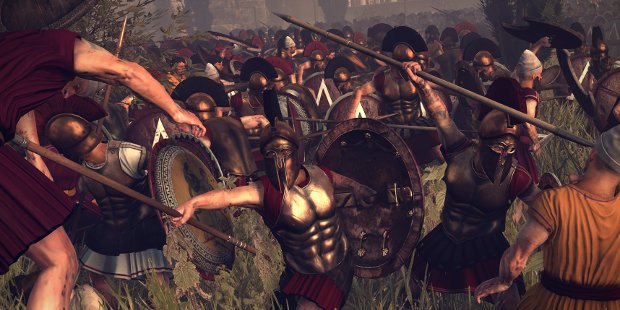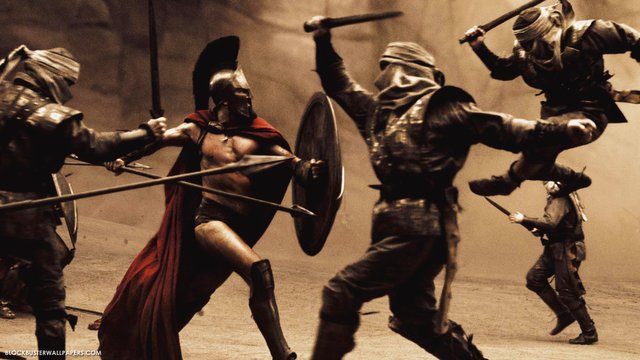**LEGEND OF SPARTANS**
HI Steemetropolis !!
Its another day and am here with my big time history to crack the myth behind the LEGENDARY SPARTAN EMPIRE in the ancient Greek World.
Its is said that this guys are indestructible, full power, strength, energy, formation, tactics, attack, and so on .
i really fair this guys.. one of the toughest Greek force that ruled for years without being defeated until the Battle of Leuctra.. and that brought the defeat and final rule of SPARTANS
The rise of Thebes, particularly thanks to the brilliant general Epaminondas, led to a crushing Spartan defeat at the Battle of Leuctra in 371, which ended the myth of Spartan military invulnerability. ... When he was assassinated, Sparta was forced into the Achaean league, losing its independence forever.
SPARTANS

NOW!! relax and enjoy the full story..
The Spartan army stood at the center of the Spartan state, whose citizens were trained in the discipline and honor of the warrior society. Subject to military drill from early manhood, the Spartans were one of the most feared military forces in the Greek world. At the height of Sparta's power – between the 6th and 4th centuries BC – it was commonly accepted that "one Spartan was worth several men of any other state. According to Thucydides, the famous moment of Spartan surrender on the island of Sphacteria, off Pylos, was highly unexpected. He said that "it was the common perception at the time that Spartans would never lay down their weapons for any reason, be it hunger, or danger."
The iconic army was first developed by the semi-mythical Spartan legislator Lycurgus.
Referring to Sparta having a "wall of men, instead of bricks", he proposed to reform Spartan society to create a military-focused lifestyle in accordance with "proper virtues" such as equality for the male citizens, austerity, strength, and fitness. A Spartan man's involvement with the army began in infancy when he was inspected by the Gerousia. If the baby was found to be weak or deformed he was left at Mount Taygetus to die, since the world of the Spartans was no place for those who could not fend for themselves. The practice of discarding children at birth took place in Athens as well. Those deemed strong were then put in the agoge regime at the age of seven. Under the agoge the young boys or Spartiates were kept under intense and rigorous military training. Their education focused primarily on cunning, sports and war tactics, but also included poetry, music, academics, and sometimes politics. Those who passed the agoge by the age of 30 were given full Spartan citizenship.
The term "spartan" became synonymous with fearlessness, harsh and cruel life, endurance or simplicity by design

Tactical structure
This is one thing the spartans have that made them undefeated....
The principal source for the organization of the Spartan Army is Xenophon, who admired the Spartans and whose Constitution of Spartaoffers a detailed overview of the Spartan state and society at the beginning of the 4th century BC. Other authors, notably Thucydides, also provide information, but it is not always as reliable as Xenophon's first-hand accounts.
Little is known of the earlier organisation, and much is left open to speculation. The earliest form of social and military organization (during the 7th century BC) seems to have been the three tribes (phylai: the Pamphyloi, Hylleis and Dymanes), who appear in the Second Messenian War (685–668 BC). A further subdivision was the "fraternity" (phratra), of which 27, or nine per tribe, are recorded.[15] Eventually this system was replaced by five territorial divisions, the obai ("villages"), which supplied a lochos of ca. 1,000 men each.[16] This system was still used during the Persian Wars, as implied by references to the lochoi made by Herodotus in his history.

The changes that occurred between the Persian and the Peloponnesian Wars are not documented, but according to Thucydides, at Mantineain 418 BC there were 7 lochoi present, each subdivided into four pentekostyes of 128 men, which were further subdivided into four enōmotiaiof 32 men, giving a total of 3,584 men for the main Spartan army.[18] By the end of the Peloponnesian War, the structure had evolved further, both to address the shortages in manpower and to create a more flexible system that allowed the Spartans to send smaller detachments on campaign or to garrisons outside their homeland.[19] According to Xenophon, the basic Spartan unit remained the enōmotia, with 36 men in three files of twelve under an enōmotarches.[20] Two enōmotiai formed a pentēkostys of 72 men under a pentēkontēr, and two pentēkostyaiwere grouped into a lochos of 144 men under a lochagos. Four lochoi formed a mora of 576 men under a polemarchos, the largest single tactical unit of the Spartan army.[21] Six morai composed the Spartan army on campaign, to which were added the Skiritai and the contingents of allied states.

THE KINGS AND THE HIPPEIS
The full army was normally led in battle by the two kings; initially, both went on campaign, but after the 6th century BC only one, with the other remaining at home.[6] Unlike other states, their authority was severely circumscribed; actual power rested with the five elected ephoroi.[1] The kings were accompanied by a select group of 300 men as a royal guard, who were termed hippeis ("cavalrymen"). Despite their title, they were infantry hoplites like all Spartiatai. Indeed, the Spartans did not utilize a cavalry of their own until late into the Peloponnesian War, when small units of 60 cavalrymen were attached to each mora.[21] The hippeis belonged to the first mora and were the elite of the Spartan army, being deployed on the honorary right side of the battle line. They were selected every year by specially commissioned officials, the hippagretai, from among experienced men who had sons, so that their line would continue.


END OF HEGEMONY
Spartan ascendancy did not last long. By the end of the 5th century BC, Sparta had suffered serious casualties in the Peloponnesian Wars, and its conservative and narrow mentality alienated many of its former allies. At the same time, its military class - the Spartiate caste - was in decline for several reasons:

Population decline due to Sparta's frequent wars in the late 5th century. Since Spartiates were required to marry late, birth rates remained low, making it difficult to replace their losses.
One could be demoted from Spartiate status for a number of reasons such as cowardice in battle or the inability to pay for membership in the syssitia. Inability to pay became such an increasingly severe problem because commercial activity had started to develop in Sparta.[clarification needed][why would this reduce wealth?] Some Spartiates had to sell the land from which they drew their income. As the constitution made no provisions for promotion to Spartiate caste, numbers gradually dwindled.
As Sparta's military power waned, Thebes repeatedly challenged its authority. The ensuing Corinthian War led to the humiliating Peace of Antalcidas that destroyed Sparta's reputation as the protector of the independence of Greek city-states. At the same time, Spartan military prestige suffered a severe blow when a mora of 600 men was decimated by peltasts (light troops) under the command of the Athenian general Iphicrates. Spartan authority finally collapsed after their disastrous defeat at the Battle of Leuctra by the Thebans commanded by Epaminondas in 371 BC. The battle, in which large numbers of Spartiates were killed, resulted in the loss of the fertile Messenia region.
And that was how Spartans were thrown out of power and till date the history still remains unforgettable in the fall of mighty men...
Thanks for Reading, hope you enjoyed it
Keep following me up for more of ME!! @juliangold
Special Thanks to @cryptkeeper @terminallyill @royaleagle
you guys are wonderful
#Follow
#Upvote
#Comment
#Resteem



Nice history
Thanks so much for checking me out...
You can keep updated for more by following me @juliangold
Nice being a friend here on Steemit...
Thanks .....
Weldone
Thanks bro...
Thank you for stopping by..
Nice to be a friend on Steemit